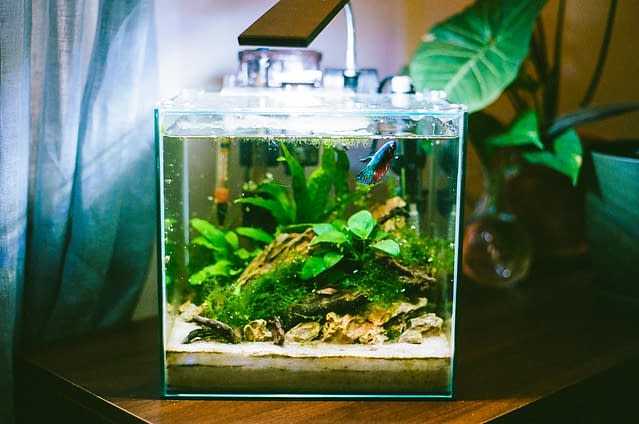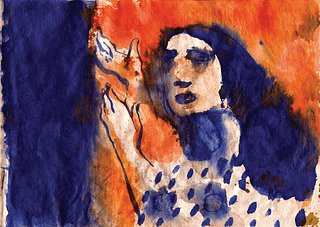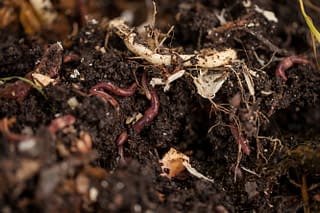
Chrissy and I play chase in the morning. I skim my finger along the surface of the water and she follows me, weaving her slender body around the aquatic plants, stones, and driftwood fragments that I’ve arranged into a loose approximation of her natural habitat. Her scales are iridescent red and blue. Her fins trail her like ribbons. She doesn’t stop until she catches me, and she always catches me because I let her. I like to pretend she’s a very good dog, patting her head as lightly as I can with my pinky. She likes to flare her gills and nip at me. She wants me to keep going, to keep running from her. I usually tap out with a freeze-dried shrimp pellet. I press it against my finger until it sticks and dangle it just a hair above the water, watching her wind herself up like a spring.
Whenever I tell people I live alone, I feel a brief and slightly ridiculous pang of guilt. It’s as if by discounting Chrissy’s presence in my apartment, I am betraying her. I moved to Iowa City from Boston last fall with her stowed away in a Tupperware container, and we now share a room, which makes us roommates in a literal, if not legal, sense. Chrissy is a betta fish, which means she keeps strictly to the five gallons of water beside my desk. Every time I sit down to write, she swims up to greet me. I make faces at her. She makes smaller faces back. Her face is nothing like my face, but I like to imagine her sloping jaw as a pout, an endearing impression of human grumpiness. I love what I see. I used to resist anthropomorphizing Chrissy, but I’ve since outgrown the impulse. The lives of fish are too short for me to maintain that kind of intellectual distance. I’ve decided a fish can be a roommate. A fish can be a roommate and a very good dog.
For a long time, I conceived of pets as animals you looked at. My father kept a twenty-gallon aquarium by the dinner table in our childhood home and I insisted on helping him decorate it. In old childhood pictures, you can see its even mix of neon-blue gravel and slightly brighter neon-blue gravel, a reflection of my four-year-old whimsy. The plastic plants I picked out were also neon, and the fish had a shiny, artificial quality to them: guppies with fins like painted fans, tetras so Crayola-bright they glowed in the dark, and a lone goldfish with the bloated appearance of a balloon animal. These fish weren’t pets in the interactive, companionable sense. They couldn’t do tricks like Chrissy. I don’t even remember if they had names. These fish were the kind of pets to be observed and admired, mostly in passing, and this was what we did, eating our meals as they swam by in a fluorescent haze, seemingly unaware of their status as transplants from some alien world. I imagined their planet as something like our own — similar enough to require the evolution of eyes and mouths, but not enough for us to share a mode of movement or communication.
I was a hyperactive, overly imaginative child, more invested in the lives of book and TV characters than my own. I didn’t want to just watch the fish, I wanted to be them, or at the very least, be with them. Aided by my photo-illustrated aquarium books and nature documentaries, I imagined myself small and tireless, surrounded by other small, tireless animals in the tributaries of the Amazon, the jungle pools of Burma, the swamps of China and Malaysia too. These wild places were where my father’s alien fish were supposed to be. Sometimes, as I watched them schooling, I wondered whether they missed their homes. I wondered whether we had done something terrible by placing them behind the glass, making them ours to look at. In the long historical arc of human-fish relations, these questions must have been asked innumerable times.
I got older. I read things. I studied literature and fishkeeping and pre-Calculus, keeping other fish in other tanks in other places. Across a series of library books and Wikipedia rabbit-holes, I traced the history of the home aquarium all the way to the kitchen. The first fish raised in captivity, I learned, became lunches and dinners. It wasn’t until the seventh century that Chinese carp farmers began to transfer livestock with red, orange, and yellow color mutations into separate ponds, keeping them off the cutting board and selectively breeding them for brighter scales. Slowly but surely, they invented the goldfish, the most popular aquatic pet in the world until the arrival of Chrissy and her betta cousins. When it became fashionable to bring goldfish indoors on special occasions and display them in bowls, some ended up staying inside permanently — today there are almost as many household goldfish varieties as dog breeds, fish with dragging fins, warped spines, and gastrointestinal defects to rival even the most purebred bulldogs.
A few years ago, I attended a goldfish breeders’ convention in Shanghai. I was in the city on a fellowship to work on a poetry manuscript. The whole project had a very loose conceit that involved tracing the paths of aquarium fish from their countries of origin to the large commercial operations exporting them. Mostly I just loitered in pet stores and the convention center. I saw hundreds of prize goldfish in undecorated glass tanks, fish with skin-growths sprouting from their heads like clusters of blackberries, scale-covered eyes, and fins twice as long as their bodies. The first-place winner in one division was an almost perfectly round orb of flesh with its dorsal fin bred out of existence, leaving its hunched back completely smooth. When I put my hand up to the glass, the fish wobbled excitedly toward me, expecting to be fed. It swam like it was still learning how. In the waterways of its ancestors, I couldn’t imagine it lasting more than a week.
If a child looked at this Shanghai goldfish side-by-side with Chrissy, they would be hard pressed to draw any meaningful connections between the two. The goldfish was more like a cartoon rendering of a fish than any living breathing animal. At some historical juncture, some farmer must have seen a carp with a patch of yellow scales and thought, not quite, and then another farmer did the same with the previous farmer’s spawn, and so on and so forth until there were ten thousand increasingly grotesque variations on an orange, finned ball. They made all the fish they wanted to see. If you believed that pets were animals to be observed and admired in the confines of an enclosure, like the fish in my childhood tank, these goldfish were the logical conclusion of that belief, the purest emblems of whatever bizarre cosmetic impulse drove people to squeeze wolves into pugs and labradoodles.
The logic goes: if you’re going to spend all your time with an animal, it might as well look strange and exciting, visually arresting, a thing worth paying attention to. I understand this to a degree. I like looking at Chrissy. I could watch her swim for hours. But unlike the goldfish at the convention, Chrissy’s beauty is rooted in movement, in what the body does and how it does it, rather than how it appears. She moves so gracefully through the water I sometimes imagine she’s been animated, like every frame of her movement is painstakingly rendered by a team of people whose life work is to make things move beautifully. Whenever I see her, I’m glad she’s there, alive, visible. Her presence feels like some kind of confirmation, though I’m not sure of what.
Knowing what I now know, I can no longer imagine my father’s old fish in the wild, not without also imagining them dead or dying. The guppies and tetras could never hack it in the motherland. Their bright scales would have been a dead giveaway for predators, their long fins an opening for tears and infections. Even if they somehow managed to survive on their own, they would remain divorced forever from the natural order, their bodies inscribed with some deep and indelible record of their old lives in tanks and bowls. Their wild counterparts would shun them. As for the Shanghai goldfish, they would die almost immediately. They couldn’t live in outdoor ponds, let alone the wild. Fish like that have never been born anywhere that was not also encircled in glass or porcelain.
Part of me believes Chrissy is somehow different from these other fish, likely the same diseased lobe of my brain that allows me to think of her as a roommate, a friend, a tiny dog. On some level, I believe that if I flew her back to Thailand and tossed her into a marsh, she would be just fine. She’s getting old, but she’s a fighter. I don’t mean this in a metaphorical sense. Before they became the most popular fish in the pet trade, betta fish were more commonly known as Siamese fighting fish, and Chrissy looks more like a wild fighting fish than most of the ornamental bettas sold in American pet stores. Her fins are short and utilitarian, suited for agility. She’s a fast swimmer, aggressive when it comes to her food. When we play the jumping game, I can imagine the speed and power of her lunge taking an opponent by surprise. The only real indicators of domestication are her scales, which are significantly brighter than the muddy coats of fighters and wild fish.
The history of Siamese fighting fish domestication goes back a thousand years, almost as long as that of goldfish. The names of both these animals reflect the human impulses behind their domestication. Goldfish were bred to shine, to look beautiful in ponds and bowls. Fighting fish were bred for conflict. I’ve been to a few gambling houses in Bangkok and Chiang Rai, establishments specializing in fish fights. It’s a very old, very simple sport. Two fish are placed in a glass jar. The jar must be large enough for them to maneuver but small enough to prevent them from hiding. Wagers are set as the fish square up. They begin striking. They lash at each other’s fins and gills, again and again, sometimes for over an hour, until one of them is too hurt to keep fighting. The money changes hands.
I went to the gambling houses because I wanted to write about them. I wanted to see what the gamblers saw in their fish, whether the animals in front of them were pets or livestock or boxers or something else entirely, whether we shared any understanding. I wasn’t able to reach a conclusion. The violence was small, but it made me queasy. I watched the gamblers instead. They drank beer and chain-smoked as their animals made and lost them money. I found myself thinking of my father. I wondered what he would have made of my sensitivity, whether he would have chalked it up to the accumulated cultural impact of Disney movies and American dog-and-cat worship, or if the fish we kept together had softened him somehow.
My father spent his boyhood in Ho Chi Minh City when it was still called Saigon. He and the other neighborhood boys bought fighting fish from a local market, playing with them the way they played with marbles or toy soldiers. It was boy versus boy, and the fish were stand-ins for the boys who owned them. They called the game đá cá, fish kicking, an underwater miniaturization of their favorite kung fu movies. As their fish did what came naturally to them, which was hurt one another, the boys watched and cheered. They had nothing to bet, and for my father, this made the stakes even higher. His fish’s triumph was his own triumph, its defeat his own defeat. It had everything to do with him. This was what I wanted as a child, bathed in the glow of our home aquarium—to be inseparable from the animals inside it. This was my father’s game. Even now, he still refers to betta fish as cá đá sometimes, inverting the construction into kicking fish, a reflection of the game, rather than cá chọi, the proper name for fighting fish. In his head, the fish are the game, the game the fish. It’s a mistake, but I understand it. He sees in every betta the fighters of his childhood, just as I see in Chrissy the shimmering guppies and tetras from our old tank, the gnarled goldfish from the Shanghai convention hall.
The typical betta lives two to four years in captivity. Chrissy is three now. She’s less active than she used to be, but I can still get her to chase me when I break the surface of the water with my finger. Knowing that she is slowing down, I feel a little slower myself. Perhaps the reason I don’t like saying I live alone is because it’s too easy for me to imagine the day it stops becoming a lie. Maybe this is why I render my fish in anthropomorphisms, all the conveniently sentimental detours that I’ve invented to get around the general notion of pet ownership, the notion that Chrissy is a pet and a fish and a pet fish, and whatever I am is only marginally different from the first fishkeepers, the carp farmers and gamblers who extracted wild animals from the marsh and trapped them where they could be seen. When you miss a thing that is not yet gone, you make what you need of it. You take detours, going where you go, seeing what you see. I see a fish. I see a roommate and a very good dog. I don’t know what she sees when she looks at me. Her eyes are tiny and unblinking.


